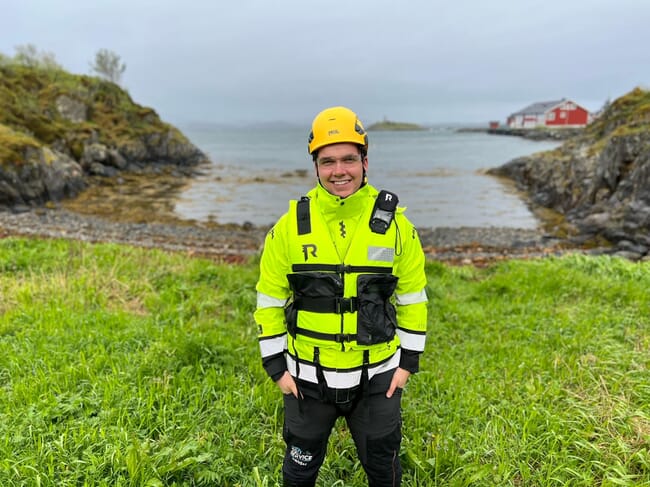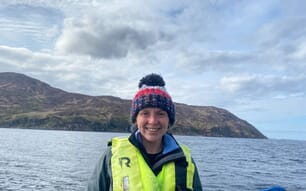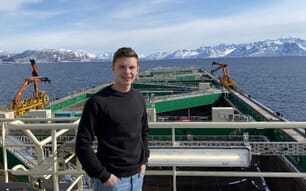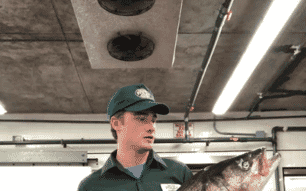
His introduction to the industry was working as an apprentice on a salmon farm three days a week while at high school
Despite growing up in a coastal community where – like in much of Norway – oil and aquaculture were the main employment options, Kristiansen admits that, until the age of 15, he knew nothing about either.
However, at that time his high school happened to offer an experimental new course – developed in conjunction with local salmon farming companies Nova Sea, Mowi and LetSea – which would give participants the chance to combine three days of study and three days of working as an apprentice on a salmon farm each week.
Despite knowing nothing about salmon farming at the time, Kristiansen was impressed by what the course appeared to offer – not only the chance to learn practical skills, but also to be paid in the process. A successful application resulted in him becoming one of the original five “guinea pigs” for the new course and a placement at a farm run by Nova Sea.
“I loved the work. It was a new experience. It was sometimes physically demanding – I’d not spent much time on boats before – but it was a great team on the farm and they taught me a lot. We had to learn everything and do everything,” he recalls.
Responsibility at a young age
Four years later, on finishing high school, Kristiansen was planning to move to Trondheim to study at university until he was offered a production manager’s role at Tomma Laks – a salmon farming company that works closely with Nova Sea – and he decided to take the position.
The role involves running a 14-cage farm, with a maximum allowable biomass (MTB) of 4.6 million tonnes, which is stocked with 1.1 million salmon at a time. The main challenges, he says, are – as in most forms of farming – biological and meteorological.
“The site is one of the most challenging in terms of weather in the whole Nova Sea Group, as it’s at the crossroads between three fjords, so the weather comes from all directions. The main biological challenges are lice,” he explains.
While his farm is productive and – currently – profitable, Kristiansen believes that there is scope for the industry to improve.
“We need to figure out how we can cope with the density – there are a lot of farms today – and how we can structure the industry so we can have the best production with the least problems with diseases, especially lice,” he explains.
Yet, despite the challenges he remains optimistic that the industry will eventually win the “arms race” against lice.
“The industry is constantly evolving, that’s what I like about it. I only started five years ago, but there have been a lot of big changes in that time, in terms of technology and methods to deal with lice. Equipment is becoming more reliable, there are bigger cages, better boats. We have new tools to cope with the problems. I think we will win the arms race – I would say there were more problems in the past with lice and with diseases,” he explains.
Alternative production systems
Novel production systems are seen by many as the best ways of avoiding current challenges, but Kristiansen is fairly convinced that some are more likely to be viable than others.
“I’m a big believer in scaled up offshore production systems, possibly using semi-closed net pens, that are four or five times the size of the ones we use now. If you put farms offshore with semi-closed systems – maybe closed down to 16m, to stop salmon lice being able to enter them – I think that’s probably the best solution. You can have much bigger farms, without the lice problems. It’s rougher for people to work on, but the farms with the worst weather tend to produce the best salmon. Farms with strong currents produce denser, less fatty fish,” he explains.
Like many net pen farmers he’s less impressed by the prospects of growing market-sized salmon indoors, especially in Norway, which is blessed with such good natural conditions.
“I don’t think land-based farms are the solution – they are not cost-effective and they are also too energy-intensive, which makes no sense in a time of energy crisis. They also take up a lot of land: if we were to transfer all Norway’s current salmon farms onto the land, they would need an area the size of Oslo-Akersus County. Land-based farms might make sense for countries with no access to the coast, but in Norway our biggest advantage is clean coastal waters which are perfect for producing Atlantic salmon,” he says.
Thoughts on the resource rent tax
A new challenge that is very much on Kristiansen’s mind is political rather than biological. Like the vast majority of the industry, he was taken aback by the Norwegian government’s sudden announcement in the autumn that it planned to hit farmers with an additional 40 percent resource rent tax.
Although the details of this tax are still being debated – the proposal was recently amended to 35 percent* – he’s extremely sceptical about whether it will bring any benefits.
“I’ve been quite active in this debate and have even talked to the Prime Minister about it, but we did not agree,” he reflects, referring to a trip to Oslo he made with Nova Sea’s chair, Aino Olaisen – as part of an initiative that aims to promote opportunities for young people in coastal communities – shortly after the tax proposal was announced.
Although he understands why the salmon sector is being targeted, he believes that the plan has numerous flaws, is based on a misunderstanding of the attitudes of many of the companies in the sector, and is also likely to be counter-productive.
As he explains: “It’s no secret that the aquaculture industry has made good money in recent years and I think that most companies would be willing to pay more taxes, especially to their local municipalities. Fish farming started as way to save local coastal communities by creating jobs, and this is still so deep-rooted in the strategies of companies like Nova Sea. The company was founded to build a community on the island of Lovund – which is basically just a mountain sticking out of the sea in the middle of nowhere.
“Although it has now grown beyond the island, with operations in several communities, the company still spends its money in the communities in which it is based.
“I think that the tax will have the opposite effect. Fish farming is a risky and capital-intensive business, if you cut the margins in half, innovation is more risky, especially for the smaller companies – both on the production and supply sides – especially if the industry goes through a less profitable phase. Smaller companies are not vertically integrated, so are reliant on the big ones. And the big ones most likely have to increase their prices up to cope with increasing costs caused by the additional tax, combined with inflation.
“The industry has made a lot of good money in the last four to five years. And in those years we should pay more money – that’s how the whole Norwegian ethos is built – but contributing more is different than getting a 40 percent tax increase overnight. It takes many years to grow a generation of fish, and it’s a complicated production process and any tax increase must be done in a way that doesn’t harm production or reduce the value created in remote communities.
“The government set a goal a few years back for aquaculture exports to increase five-fold by 2050. If they really want to achieve this then cutting the profits in half will not help.”

His business aims to improve fish health and he’s in the process of designing his own unique vessel
An emerging entrepreneur
The new tax also puts Kristiansen’s personal ambitions at risk, as he’s currently in the process of designing his own unique vessel, which would allow him to take his own company, Akti Aqua Services, to the next level.
It’s too early for him to divulge the details of what he intends to use the vessel for, but he’s optimistic that his business – which aims to improve fish health – has potential.
“It’s not easy to set up an independent business, there are many service companies with 20 or 30 vessels, so I need to make sure I have enough capabilities to do a range of jobs. It’s early days, but it’s looking pretty promising and I’ve had a lot of positive conversations with farmers,” he says.
He’s been very impressed by the level of support he’s received from the sector ever since he first signed up as an apprentice. And it’s taken him right to the top – both in the business and in the country itself.
“I’ve had the opportunity to meet a lot of key people in the industry and learn a lot from them: fish farmers love to share knowledge. It’s the way the business was built in order to overcome all the challenges in the early days and that spirit still lives in the industry today,” he argues.
Kristiansen was particularly impressed by the amount of positive advice he'd received from existing service providers, even though he is setting up as a potential competitor to them.
As a result, he’s optimistic that – tax or no tax – he’ll be able to both make his business a financial success and help to solve many of the issues that currently plague the salmon industry.
*Later in the day this article was published the resource rent tax, which had been adjusted to 25 percent, was passed by 93 votes to 76 by the Norwegian parliament.








